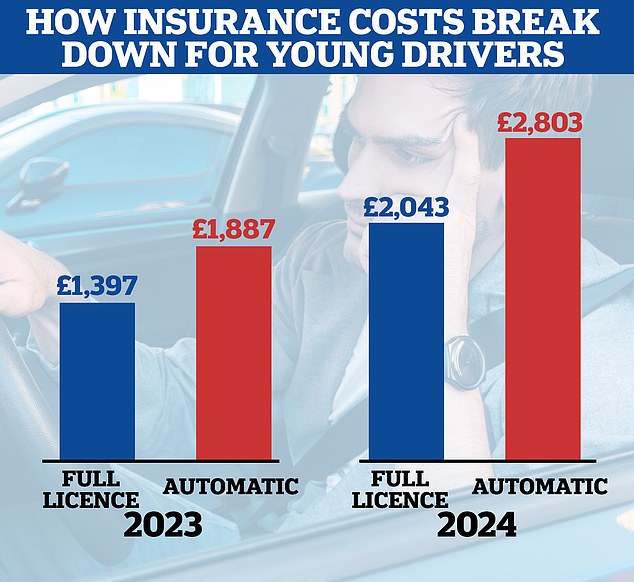Despite the growing popularity of automatic cars it still pays to learn with a manual gearbox, with younger drivers on automatic-only licences paying the highest of all car insurance premiums.
Last year the typical automatic-only driver aged under 25 was quoted £2,803 a year for their car insurance, a rise of 49 per cent on £1,887 in 2023, according to price comparison website Compare the Market.
Young drivers of cars with automatic gearboxes paid £490 more for cover than those with full licences in 2023 – but £760 more in 2024.
Automatic car drivers pay more for insurance because the gearboxes are more expensive to fix, and insurers say they also cause more claims.

Automatics for the people?: Non-manual gearboxes are increasing in popularity, but younger drivers who shun manual cars must brace for far higher insurance premiums
Rising premiums are worrying news for the growing pool of young drivers who can only drive automatics.
Figures from the DVLA show that in 2022-23, 138,354 people passed their driving test in an automatic, compared to 34,749 people in 2012-13.
The increasing number of young drivers only learning to drive automatics may be partly due to the popularity of electric vehicles as some car manufacturers are set to stop producing new manual car models.
Julie Daniels, of Compare the Market, said: ‘The increasing cost of car insurance is concerning for young drivers across the board, particularly those who have only learnt to drive automatic cars.
‘These drivers face paying over £900 more this year to insure their car.
‘If the cost of driving continues to increase, it may force some young motorists off the road.’
Figures from the comparison website are based on the premiums that drivers are quoted through its platform, not what drivers actually pay.
Car insurance now makes up 66 per cent of the total car running costs for young drivers.

Compare the Market said the total annual car running cost will be £3,043 on average for a young driver in 2024.
This figure is made up of insurance (£2,009), fuel (£799), vehicle excise duty (£180) and an MOT (£55).
The £3,043 figure is a 25 per cent increase from 2023 when the average running cost was £2,436.
Compare the Market said nearly four in five are worried about the cost of their car insurance policy.
How young drivers can save money on car insurance
1. Shop around
Car insurance bills have a habit of creeping up, so comparing prices for the best deal is a wise move.
Use more than one price comparison website to make sure you are getting the full range of possible quotes.
2. Consider a telematics (black box) policy
Black box policies are where the insurer installs a system in your car to monitor your driving. This is designed to reward those who drive carefully.
Many of these devices are aimed towards younger motorists, who can dramatically reduce their high premiums by installing one and proving themselves a sensible driver.
However, any motorist is able to get one. Officially called telematics, these devices check your speed, how aggressively you accelerate and brake, and how cautiously you drive.
They also record whether you are on the road at ‘dangerous’ times, for example in the early hours of the morning.
3. Pay annually
When taking out a new policy, drivers will be given the option to either to pay for the whole year upfront or in monthly instalments.
Many opt for the monthly payments as it means not having to part with a large sum of money in one go – but if you can afford to pay your yearly premium upfront, you could save money.
This is because your insurer may charge you interest on the monthly instalments. It is worth asking them if there is a difference and if so, what it is.
4. Increase your voluntary excess
Car insurance excesses are made up of two parts, the voluntary excess and the compulsory excess.
The voluntary excess is the amount a driver agrees to pay towards the cost of a claim, and it can be changed when getting a quote or buying a policy. When a driver increases the voluntary excess it usually results in a lower premium.
Meanwhile, the compulsory excess is set by the insurer and cannot be changed or negotiated.
However, it is very important to make sure you can afford to pay the total excess, should you need to claim.
5. Secure your car
Fitting an approved alarm, immobiliser or tracking device can get drivers an insurance discount of around 5 per cent.
6. Do fewer miles
A lower mileage can help keep insurance costs down. The fewer miles that you drive, the less time you are on the road and the less likely you are to have an accident – so insurers will often look favourably upon this lower risk and price your premiums lower.
But you must be honest about your annual mileage as inaccuracy will jeopardise any claim.
7. Could you change the model of your car?
Choosing the right model of the car is important for young drivers, as they typically face the highest premiums and will not want to choose a car model that makes it even more expensive.
Lots of factors can influence how much a car model costs to insure, including engine size, security features, and repair costs. Normally, the bigger engine your car has, the higher the insurance premium.
Drivers should also avoid buying a car with customised modifications such as spoilers or wheel rims, as these can increase insurance premiums.
The age of a car can change how much it will cost to insure, but it works both ways.
Older cars are usually worth less, so they’re cheaper to replace, but they also have fewer modern safety features, which can also make them more of a risk.
Some links in this article may be affiliate links. If you click on them we may earn a small commission. That helps us fund This Is Money, and keep it free to use. We do not write articles to promote products. We do not allow any commercial relationship to affect our editorial independence.





